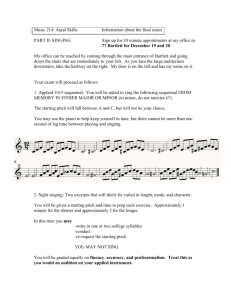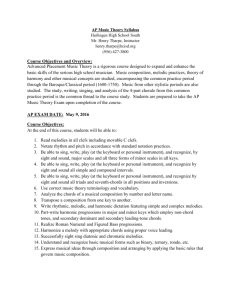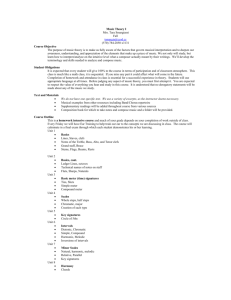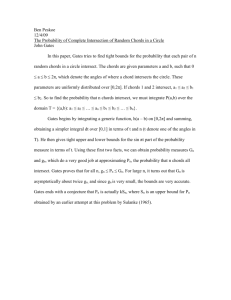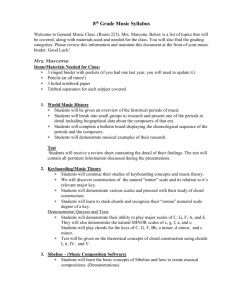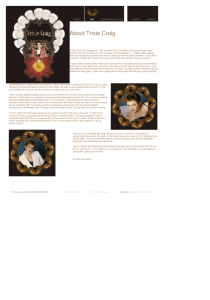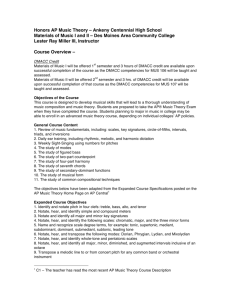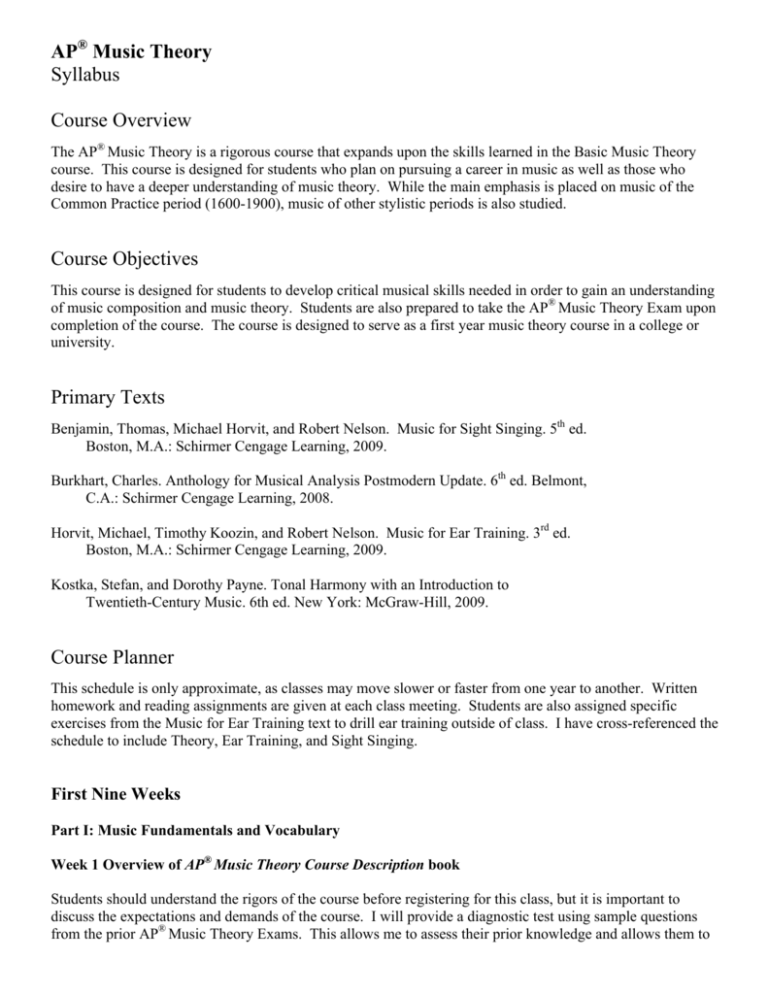
AP® Music Theory
Syllabus
Course Overview
The AP® Music Theory is a rigorous course that expands upon the skills learned in the Basic Music Theory
course. This course is designed for students who plan on pursuing a career in music as well as those who
desire to have a deeper understanding of music theory. While the main emphasis is placed on music of the
Common Practice period (1600-1900), music of other stylistic periods is also studied.
Course Objectives
This course is designed for students to develop critical musical skills needed in order to gain an understanding
of music composition and music theory. Students are also prepared to take the AP® Music Theory Exam upon
completion of the course. The course is designed to serve as a first year music theory course in a college or
university.
Primary Texts
Benjamin, Thomas, Michael Horvit, and Robert Nelson. Music for Sight Singing. 5th ed.
Boston, M.A.: Schirmer Cengage Learning, 2009.
Burkhart, Charles. Anthology for Musical Analysis Postmodern Update. 6th ed. Belmont,
C.A.: Schirmer Cengage Learning, 2008.
Horvit, Michael, Timothy Koozin, and Robert Nelson. Music for Ear Training. 3rd ed.
Boston, M.A.: Schirmer Cengage Learning, 2009.
Kostka, Stefan, and Dorothy Payne. Tonal Harmony with an Introduction to
Twentieth-Century Music. 6th ed. New York: McGraw-Hill, 2009.
Course Planner
This schedule is only approximate, as classes may move slower or faster from one year to another. Written
homework and reading assignments are given at each class meeting. Students are also assigned specific
exercises from the Music for Ear Training text to drill ear training outside of class. I have cross-referenced the
schedule to include Theory, Ear Training, and Sight Singing.
First Nine Weeks
Part I: Music Fundamentals and Vocabulary
Week 1 Overview of AP® Music Theory Course Description book
Students should understand the rigors of the course before registering for this class, but it is important to
discuss the expectations and demands of the course. I will provide a diagnostic test using sample questions
from the prior AP® Music Theory Exams. This allows me to assess their prior knowledge and allows them to
get a feel for the things we are going to cover throughout the course. We will review the test and the various
questions as a class and discuss the theory topics covered in the question.
Chapters from Tonal Harmony with an Introduction to Twentieth-Century Music
Sight Singing Chapters from Music for Sight Singing
Weeks 2-3
Week 4
Week 5-6
Week 7-8
Week 9
Chapter 1
Elements of Pitch (Major/Minor Scales and Key Signatures,
Intervals and Inversions)
Chapter 2
Elements of Rhythm (Beat, Simple/Compound Time Signatures)
Chapter 3
Introduction to Triads and Seventh Chords (Inversions and
Figured Bass)
Chapter 4
Diatonic Chords in Major and Minor Keys (Triads and Seventh Chords)
Mid-Semester Exam
Sight Singing and Ear Training
Music for Sight Singing
Week 2
Week 4
Week 6
Week 8
Chapter 1
Chapter 2
Chapter 3
Chapter 4
Introduction to Solfège/One and Two-Pulse Units/The Major Scale
Simple Meters/Intervals: Thirds and Fourths
Tonic Triad in the Major Mode: Fifths, Sixths, and Octaves
Subdivisions of the Beat/ I, IV, V7; Introducing Sevenths
Second Nine Weeks
Part II: Part Writing and Counterpoint
Week 1
Week 2
Week 3
Week 4
Week 5
Week 6
Week 7
Week 8
Week 9
Chapter 5
Principles of Voice-Leading (Melodic Lines and Notation)
Chapter 6
Root Position Part Writing (Ranges and Transpositions)
Chapter 7
Harmonic Progression and the Sequence (The Various Chords)
Chapter 8
Triads in First Inversion
Chapter 9
Triads in Second Inversion
Chapter 10
Cadences, Phrases, and Periods
Chapter 11
Nonchord Tones 1 (Passing, Neighboring, Suspensions)
Chapter 12
Nonchord Tones 2 (Appoggiaturas, Escape Tones, Pedal Point)
Semester Exam
Sight Singing and Ear Training
Music for Sight Singing
Week 2
Week 4
Week 6
Week 8
Chapter 5
Chapter 6
Chapter 7
Chapter 8
Anacruses/Introducing Alto Clef/I, IV, V, V7 Part II
Rhythmic Dots and Ties/Minor Mode
Music from the Literature
Compound Meter/Supertonic, Submediant and Mediant Triads
Third Nine Weeks
Part III: Diatonic Seventh Chords
Week 1-2
Week 3
Chapter 13
Chapter 14
The V7 Chord (Various Forms and Approach to the 7ths)
The II7 and VII7 Chords (Major and Minor)
Week 4
Chapter 15
Other Diatonic Seventh Chords (The IV7, VI7, I7, III7, Circle of Fifths)
Part IV: Chromaticism and Secondary Functions
Week 5
Week 6
Week 7
Week 8
Week 9
Chapter 16
Secondary Functions I (Secondary Dominants)
Chapter 17
Secondary Functions II (Secondary Leading-Tones)
Chapter 18
Modulations Using Diatonic Common Chords
Chapter 19
Some Other Modulatory Techniques (Altered Chords, Common Tone)
Mid-Semester Exam
Sight Singing and Ear Training
Music for Sight Singing
Week 1
Week 3
Week 5
Week 7
Week 9
Chapter 9
Chapter 10
Chapter 11
Chapter 12
Chapter 14
Triplets and Duplets/Seventh Chords III
Music from the Literature
Syncopation and Other Seventh Chords
Decorative Chromaticism (Inflected Scale Degrees, Scalar Variants)
Secondary Dominants
Fourth Nine Weeks
Week 1
Chapter 20
Binary and Ternary Forms (12-Bar Blues, Sonata, Rondo)/
Introduction and Analysis of 20th Century Compositional Techniques
Part V: Chromaticism II and Exceptional Chords
Week 2
Week 3
Week 4
Weeks 1-5
Weeks 1-5
Weeks 1-5
Weeks 1-5
Week 6
Weeks 7-9
Chapter 21
Mode Mixture (Borrowed Chords, Modulations)
Chapter 22
The Neapolitan Chord
Chapter 23
Augmented Sixth Chords (Italian, French, German)
Dictation Exercises – Melodic, Harmonic, and Rhythmic
Free-Response Question Exercises
Recorded Sight-Singing Exercises
Students complete and review AP® Music Theory Exams from previous years
Complete AP® Music Theory Examination
Student composition projects and analysis
Student Evaluation
A program called Genesis® is used to record and calculate all grades for this course. Grades are weighted to
ensure that the appropriate value is placed on each of the class concepts presented. Students will be assessed
on the theoretical concepts through written quizzes and tests. They will be evaluated on sight singing and ear
training through dictation and singing quizzes. Students will also have to conduct time patterns and clap
rhythms in order to better reinforce certain concepts. Homework will also be an important tool in this course
and will serve as knowledge checkpoints.
Course Grade Weighting by Semester
Theory
Workbook Assignments
Aural Skills
Homework
Participation
30%
20%
20%
5%
5%
Mid-Semester and Semester Exams
20% (10% each)
Teacher Resources
Carothers Hall, Anne. Studying Rhythm. 3th ed.
Upper Saddle River, NJ.: Pearson Prentice Hall, 2005.
Green, Douglass M. Form in Tonal Music: An Introduction to Analysis. 2nd ed.
Belmont, CA.: Wadsworth Thomson Learning, 1979
Kostka, Stefan. Materials and Techniques of Twentieth-Century Music. 3rd ed.
Upper Saddle River, NJ.: Pearson Prentice Hall, 2006.
Ottman, Robert W. and Nancy Rogers. Music for Sight Singing. 7th ed.
Upper Saddle River, NJ.: Pearson Prentice Hall, 2007.
Technology Aids
MacGAMUT 6 (for Mac and Windows). Columbus, Ohio: MacGAMUT Music Software.
www.macgamut.com
Practica Musica 5. Redmond, Washington: Ars Nova Software, LLC.

